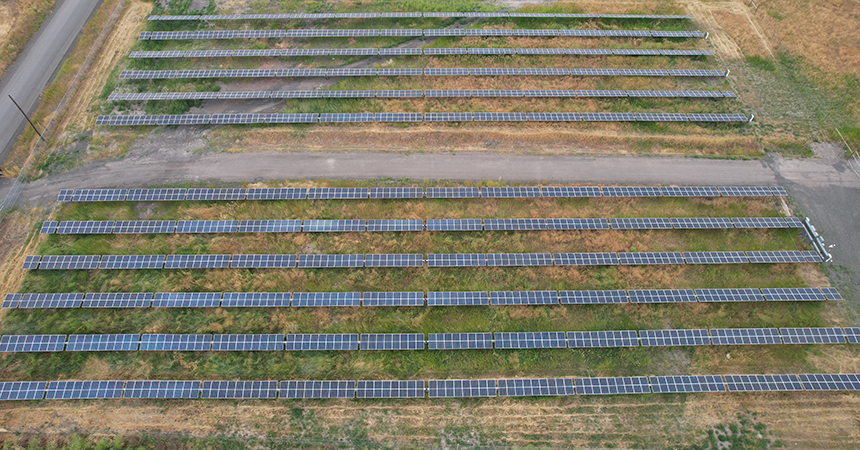Photos courtesy of Wallowa County Community Solar
Enjoying the benefits of solar power might seem out of reach for someone experiencing a lower income and living in an apartment in a small, rural town. But tenants of two affordable housing apartment buildings in the city of Wallowa will save on energy costs for years to come thanks to a new community solar project that began generating energy in July.
The 360-kilowatt Wallowa County Community Solar project was developed by Fleet Development, a company created to bring renewable energy to affordable housing—specifically the buildings administered by Viridian Management, a sister company within the Chrisman Group.
When the Oregon Community Solar Program was getting off the ground, Ryan Sheehy, president, Fleet Development, saw a perfect opportunity to join in the early planning and make sure the program could work for low-income housing.
“I noticed there was a requirement for 10% of project enrollment to be low-income. We figured people would ask to subscribe Viridian tenants, and we wanted to be involved in that because it needed to be done right. There are a lot of rules regarding tenants and federal housing. The more I read about it, the more I thought we should develop our own project,” Sheehy said.
Community solar was created as an accessible, affordable option for renters and others who want to use solar energy but might not have a sunny roof or the budget to invest in a standalone system.
“I spent about four years working through obstacles to make this project work. I participated in stakeholder meetings as an advocate for low-income access in community solar,” Sheehy said. “I was particularly interested in making sure the rules and implementation of the program allowed multifamily affordable housing to be involved.”
Subscribers to community solar projects are credited through their electric bills for their portion of the energy generated. But Sheehy recognized that solar bill credits created an obstacle for affordable housing residents. Federal guidelines set affordable housing rent at 30% of a tenant’s income, and a bill credit would count as income. So, as energy costs go down and solar bill credits go up, then rent would go up as well—in effect, cancelling out the solar savings.
The solution for Viridian? The property management company subscribed two apartment buildings in Wallowa—a total of 18 apartments—to Wallowa County Community Solar as the low-income portion of the project. They replaced individual tenant utility accounts for each apartment unit with one main account for each complex. Viridian pays the bills, collects the solar credits and then passes the savings to the tenants.
“After a year of generation, we calculate what their savings would be as a subscriber and provide that amount to them as an annual energy assistance grant, which is not counted as income. So, it ends up in their pocket instead of raising the rent,” Sheehy said.
Under Oregon Community Solar Program rules, low-income subscribers must receive at least a 20% discount compared to the bill credit a regular participant receives. But, in this case, Fleet Development donates a 100% discount to the tenants.
“We want Wallowa County Community Solar to be a leading example of what community solar can do for some low-income tenants. The free subscription has a dollar value equivalent to about 80% of their annual energy costs, or about $500 a year,” he said.
Beyond the low-income portion of the project, other Viridian affordable housing properties are also enrolled in Wallowa County Community Solar—three apartment complexes in Enterprise and two in the southern Oregon communities of Eagle Point and White City—as regular residential participants in the project. As with the other buildings, the individual tenant utility accounts have been replaced by one main account for each complex. Viridian pays the utility bills and collects the solar credits.
“Affordable housing operates on a very slim margin. Solar power is a hedge against rising utility rates to control costs over the long term for Viridian and their tenants,” Sheehy said. “And Viridian can apply the savings to address things like deferred maintenance for the residents. It helps keep the buildings viable for the communities.”
Wallowa County Community Solar is expected to generate over 894,000 kilowatt-hours of renewable power in the first year, which is enough to cover about 80% of the energy usage for Viridian’s subscribed apartments.
Enterprise Electric, an Energy Trust trade ally, constructed the ground-mount array with 1,293 panels on a 2.5-acre plot on the edge of Enterprise. Except for the two affordable housing complexes in southern Oregon, all the buildings subscribing to the project are within several miles of the location.
“This project really reflects the community solar ideal—that it is a project primarily for the local community,” Sheehy said.
The $1 million project received an Energy Trust Community Solar Development Assistance incentive, which was created to help local organizations navigate the technical hurdles of community solar project development, and a Renewable Energy Development Grant from the state of Oregon. Energy Trust also helps administer the Oregon Community Solar Program as a subcontractor.
“I’m concerned about the environment and believe this solar project helps with that. But for me, it’s all pie in the sky unless you show some financial benefit,” Sheehy said. “For our customers and tenants, controlling costs is the number one thing on their mind. And it feels good to be bringing something to the property management industry that helps control costs and it’s the right thing to do for them.”
Interested in developing a community solar project? Learn more about how Energy Trust can help with Community Solar Development Assistance, Community Solar Coaching Assistance and Community Solar Incentives.

